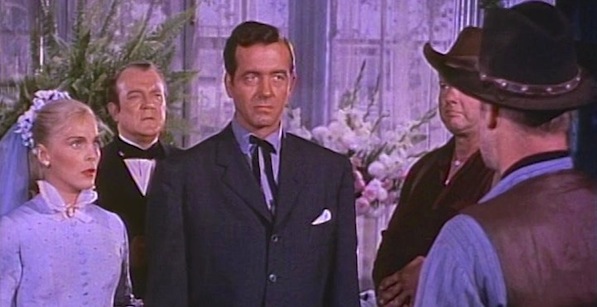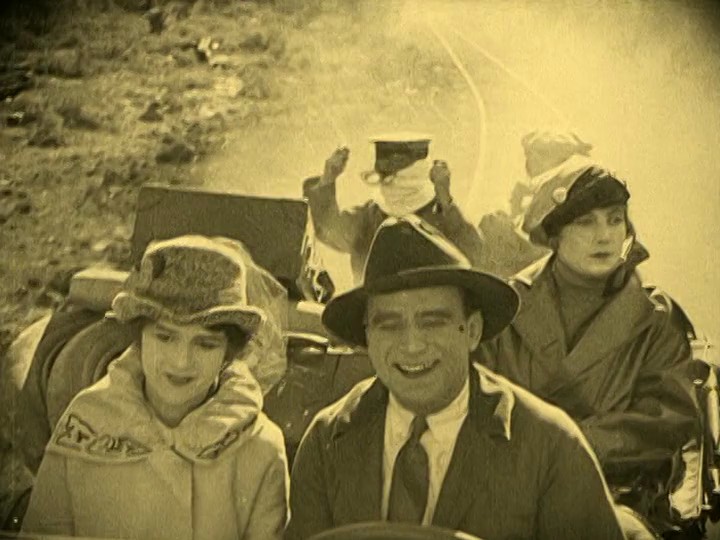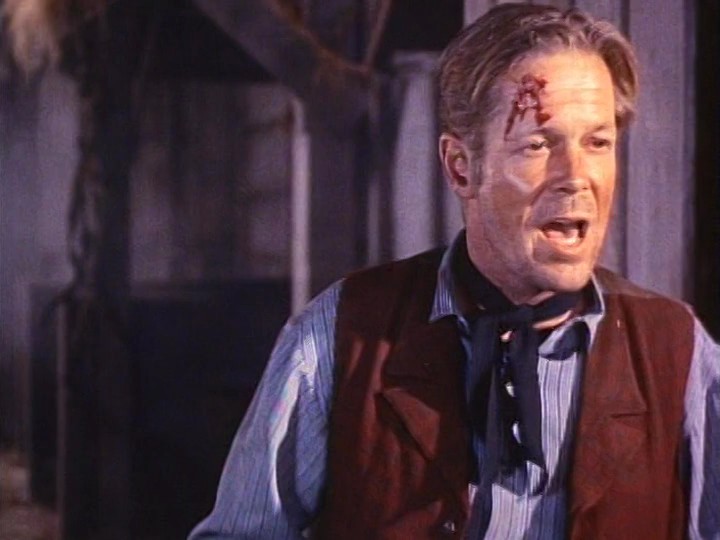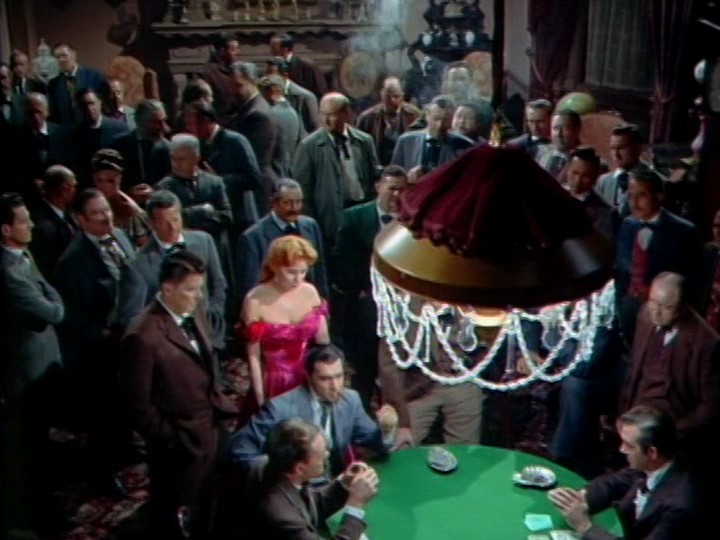Somewhere exists a composite Allan Dwan film. In it, one person loves another, though won’t reveal how much. There is a past self that she’s hiding from view because he knows he’d suffer too much pain if it were to come out. Dwan’s prostitutes, gamblers, vagrant soldiers, illegitimate mothers, outlaws and outcasts ache from their buried loneliness and from their fear of its discovery. They long to start their lives afresh as the selves they see reflected in another person’s eyes.
Quite often they succeed in grand style befitting the American Myth: Love comes accompanied by a good bit of money, property and the assurance of steady meals and safety from the arbitrary whims of the Law. But Dwan’s people have to run a lot to reach that point, and race alone, with their loved ones only joining them near the finish line. Until that point, they are literally hunted by a whole society, whose inchoate mob anger can be triggered by something as senseless as a con man pointing a finger and saying “He did it” in order to cover up his own tracks. The dream of building a new, small group with just one other person eases the nightmarish reality of being excluded by all the others. In Dwan’s 1946 film Rendezvous with Annie, an American Army private (played by Eddie Albert) soon to go AWOL sits in a bomb shelter waving his hands and smiling. Catastrophic sounds go on roaring above, while bliss fills his memories of his wife’s chocolate cake.
Annie came thirty-five years into Dwan’s directorial career, and fifteen years before it ended. The half-century that that career inhabited—which included roughly 400 action-packed variants on genres whose range included historical epic, social drama, screwball comedy and western is currently being honored through Allan Dwan and the Rise and Decline of the Hollywood Studios, a forty-film retrospective (consisting of thirty six features and four shorts) running at New York’s Museum of Modern Art (MoMA). The retrospective has been timed to coincide with the publication of the eponymous first book-length critical study of Dwan’s work, written by Frederic Lombardi, who will appear in person at screenings. (A large multilingual Dwan dossier co-edited by David Phelps and Gina Telaroli has also recently come out online.)
Though there’s been notable Dwan writing published prior to now (including Allan Dwan: The Last Pioneer, Peter Bogdanovich’s book-length interview with him; Kevin Brownlow’s chapter on Dwan in his Hollywood history The Parade’s Gone By; and Donald Phelps’s remarkable critical essay “The Runners,” republished in the Phillip Lopate-edited anthology American Movie Critics: From the Silents Until Now), to my knowledge he has largely escaped sustained critical attention. Clear logistical hurdles exist: Like other Hollywood filmmakers whose company he shares in the “Expressive Esoterica” category of Andrew Sarris’s guidebook The American Cinema: Directors and Directions, 1963-1968, he made many quick, cheap, disposable-by-design films for a wide variety of studios, leaving a trail that’s been hard to follow.
Even Lombardi has been unable to see much of Dwan’s work (several of the films simply no longer exist), but nonetheless, his book’s thesis is that by studying Dwan’s career we can better understand the historical trajectory of the Hollywood studio system. Dwan, a Canadian immigrant, began towards the start of the silent era working with no less than D.W. Griffith, for whom he invented the dolly shot. Dwan mastered the enormously popular genre of the chase film, and would go on to track throughout the action sequences of the ten such action movies that he made with star Douglas Fairbanks, including extravagant spectacles such as Robin Hood (1922) and The Iron Mask (1929) as well as smaller fare like A Modern Musketeer (1917, and one of seven Dwan films streaming here). In Musketeer, made for the studio Artcraft Pictures Corp. (which would merge with Paramount a few years later), Fairbanks plays the “always chivalrous, always misunderstood” contemporary Kansas boy Ned Thacker, who lives out his dream life as a modern-day D’Artagnan devoted to protecting womens’ honor by slugging seemingly every man in sight. Fairbanks famously insisted on always performing his own stunts, an early one of which involves him in unbroken flight as he leaps over a table, hurling chairs left and right, on his way towards scaling acrobatically onto rafters and swinging at potential assailants. But while a 17th-century Frenchman might look heroic for this behavior, modern urban America does not greet it so kindly. The misfit Ned can only redeem himself to society in the great outdoors, which he eventually does by saving the lovely Elsie Dodge (played by Marjorie Daw) and her rich, duplicitous fiancée (played by Eugene Ormonde) from villainous Indians. (Like many Hollywood films of the time, this one holds an unfortunate view of Native Americans; and as for whether Elsie ultimately chooses to go with Ned or with her fiancée, you can probably guess.)
Dwan had made his way to directing by first working as an engineer and as a writer, and the constant movement that his films record, such as Ned’s breathless mountain-scaling on his way to rescue Elsie, reflects a kind of creative problem-solving that combines these two previous jobs. Dwan sought to tell stories in motion. The critic Dave Kehr has perceptively argued (in the recently issued online Dwan dossier) that Dwan’s camera movements never exist to call attention to themselves, but always serve to keep the story going. The characters are in flight, and the film does its best to keep up with them.
Kehr has argued elsewhere that a tendency towards flight also propels the films of Dwan’s contemporary Raoul Walsh, though to different ends. In Walsh’s oft-fatalistic films the characters race towards self-obliteration, with the hope of doing some good before they die; by contrast, in Dwan films the characters rush jet-fueled by their hopes of building a good life for themselves and their beloveds. A Modern Musketeer, like many of Dwan’s subsequent films, travels a fairly clean path from early comedic scene-setting towards increasingly straightforward action sequences as Ned’s dreams of a life with Elsie careens closer to coming true. Its climax shows the fresh-faced Ned, suit jacket off and sleeves rolled up, sling a coil of rope into a Colorado canyon, then swinging across it with Elsie on his back.
The lone respites from pure forward motion come within small bubbles that give space for characters to reveal their desires. In the middle of a pre-mayhem car ride Elsie asks Ned, “Are you married?” Ned laughs, then worriedly and hurriedly says, “No. Are you?” He laughs again, and then quickly looks at her, awaiting her answer. Other business distracts her from answering; Ned finds occasion to make a joke and lead them to laugh together a few minutes later. It’s typical in a Fairbanks film for the jocular actor to burst into laughter, as though to encourage everyone around him to have as good a time as he’s having, but the characters’ shared laughter often comes as a natural culmination of events. In this film, by contrast, Ned and Elsie laugh together, as though they’ve allowed themselves a secret moment together. Our position within the scene has shifted by this point from a frontal overhead view of the pair to a closer side view, as though joining them.
Dwan went on to make and break partnerships at a variety of studios. They included Republic Pictures, where he directed John Wayne to the star’s lone Best Actor Oscar nomination in the great war film Sands of Iwo Jima (1949), and where he grew firmly ensconced making westerns with collaborators that included producer Benedict Bogeaus, cinematographer John Alton, and leading actor John Payne, including what is probably his most famous film after Iwo Jima, the blacklist parable Silver Lode (1954). (The crazed atmosphere of this film is captured well by Chuck Stephens in a recent Keyframe essay.) Republic capitalized on the popularity of the western as a low-budged experience still epic enough to attract audiences away from television. The studio is likely best-known for producing Nicholas Ray’s romantic western Johnny Guitar (1954), which, like Dwan’s contemporaneous Tennessee’s Partner (1955) allows us to feel the unspoken kinship (including unspoken layers of) distance between a man and a woman as they face each other at night. Tennessee (played by Payne) is a famed gambler whom the town sheriff would love to find a reason to arrest; when another man asks if Tennessee has ever cheated, the card sharp pauses tensely and says “I’ve been accused of it.” Duchess (played by Rhonda Fleming), who once worked as a prostitute, runs a place called the Marriage Market where young women feed caviar to male customers, ostensibly as their potential future wives; when someone asks her if her home’s sign is really “on the level,” Duchess takes a glance up and down and answers, with a small considering bounce, “Most of it.”
These two moments of isolated people (each of which is even rendered in atypical close-up, in a film whose camera far more often rides through medium and long shots) suggest an invisible link between them. Both Duchess and Tennessee are building honest livings from buried shame. “Happiness doesn’t come cheap, nor can you get it on credit,” Duchess tells one of her male customers, while simultaneously speaking for Tennessee’s devotion to his gambling and for her feelings for him. “You’ll have to pay for it.”
Much of the film’s running time is given over to interactions between Tennessee and Cowpoke (played by Ronald Reagan), an ingenuous younger gunslinger who becomes Tennessee’s friend after saving his life, and who eventually works with the gambler to try to clear him of a murder charge. Yet while the film’s title might initially seem to refer to the bond between the two men, the horseplay and gunplay in which Tennessee involves himself are informed by a key early encounter that he and Duchess share near the Marriage Market’s stairwell one evening, framed in a medium shot that moves slightly to contain them both. He kisses her, to which she says that he hasn’t given her a marriage kiss. “Kiss me just once, like you really want to marry me,” she pleads. He kisses her again, and the film fades to black without resolving whether he has done so.
Duchess hopes Tennessee will place her on the level. The suspense of the subsequent action sequences is only superficially tied to whether Tennessee can survive any physical threats—we know he will. The film’s far deeper suspense comes from the time that Tennessee and Duchess spend alone together, from what this quiet man thinks of her and from whether his love is fast and strong enough to reward her hopes.
Thanks for research help to Imogen Smith, Cullen Gallagher and Charles Silver, the programmer of the Museum of Modern Art series Allan Dwan and the Rise and Decline of the Hollywood Studios.
Aaron Cutler works as a programming aide for the São Paulo International Film Festival and keeps a film criticism site, The Moviegoer.








